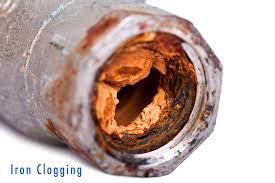
Iron in Water Solutions
The EPA recommended maximum allowable level for iron in water as a secondary contaminant is .3 parts per million and for manganese is .05 parts per million. Notably, small amounts of these minerals can create very impactful, even devastating affects on your home’s water quality. Additionally, they can interfere with many cleaning tasks, from doing the laundry to washing dishes to taking a shower. Also, washing your hair may leave it feeling sticky and dull or even discolor it. Dishes and glasses get spotted and a film may build up on shower doors, bathtubs, sinks and faucets. Clothing can look dingy and feel rough and scratchy. Furthermore, Iron can also cause a residue to build-up in pipes that can lower water pressure. For a link to the town’s annual water quality report, see https://www.plymouth-ma.gov/844/Water.
High Efficiency Water Softener

High Efficiency Water Softener
OTHER AFFECTS
Iron (see photo below) can build-up inside your water using appliances. Additionally, some other affects include corrosion and scaling inside pipes and major staining throughout the home’s showers, bathtubs, and sinks. Concurrently, for those using their water for outside lawn irrigation, iron and manganese can cause major staining of outside walkways, house siding and anyplace the water touches. See the link at https://h2ocare.com/lawn-irrigation/.

Dissolved Iron Staining
WATER SOFTENER FOR REMOVAL
Fortunately, water softening is effective in removing dissolved forms of iron & manganese and hardness minerals. Additionally, utilizing a cartridge filter with proper micron rating will be effective in removing particulate forms. Selecting the appropriate micron rating and style of filter can be determined by a water treatment professional based on water test results and other symptoms. Notably, water softeners vary, including up-flow versus down-flow which can make a big difference, particularly if there are elevated levels of iron or manganese in the water.

Iron Clogging
For more on hard water, see hard water epa.


